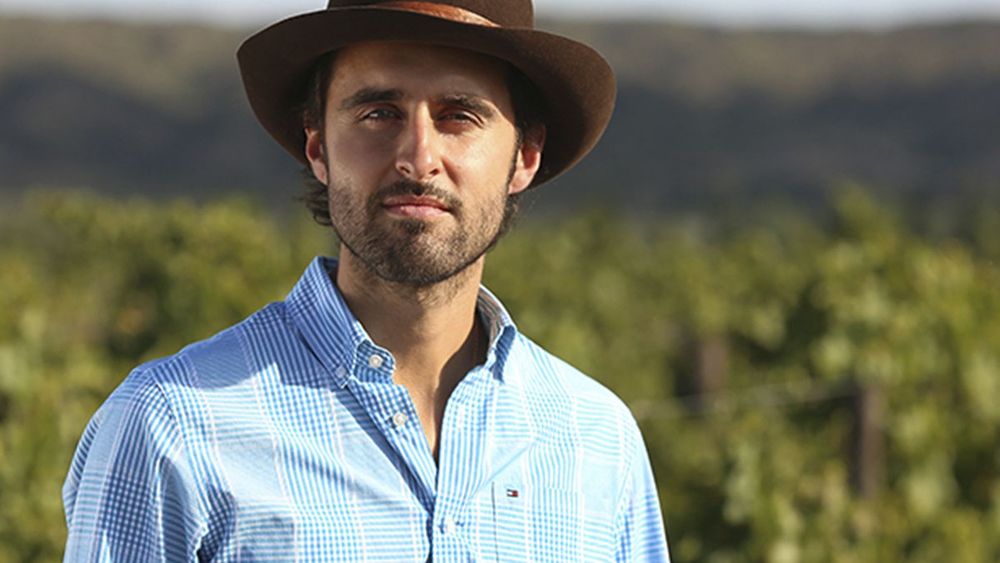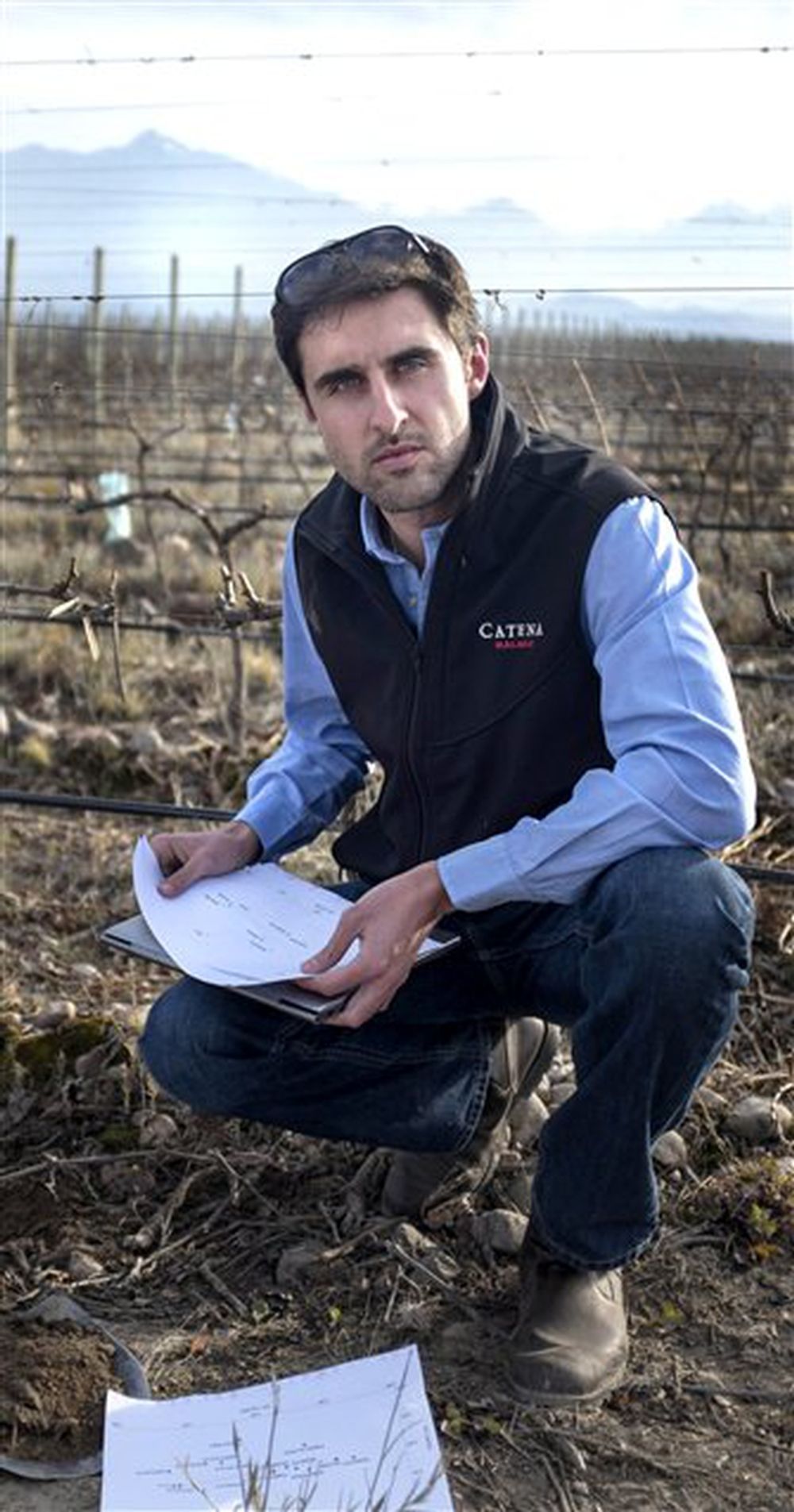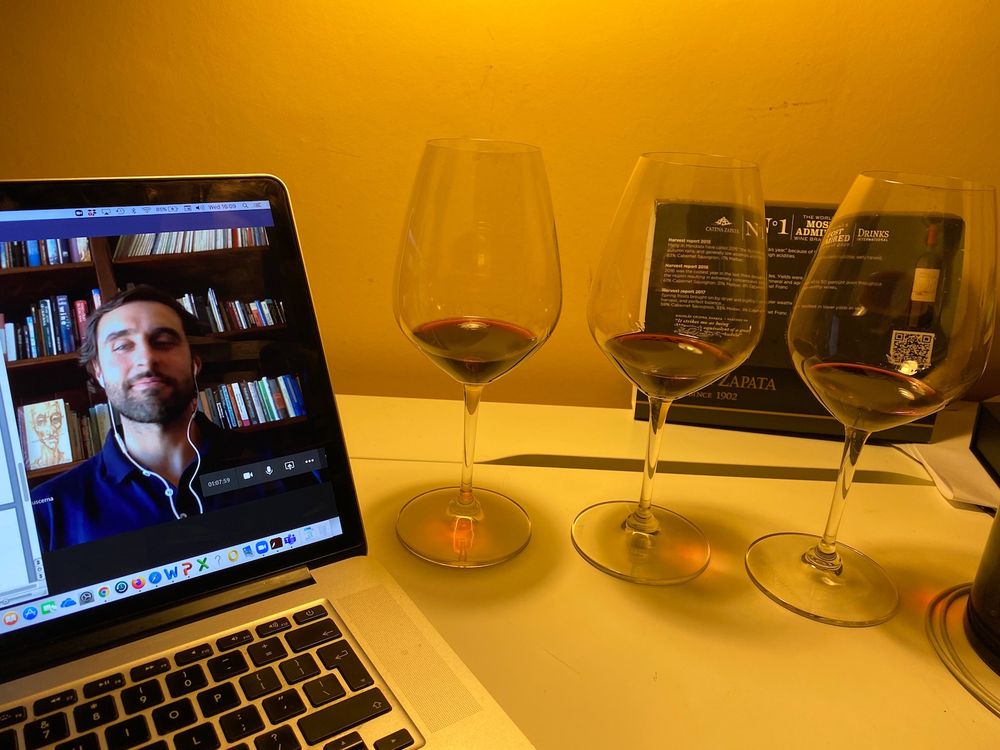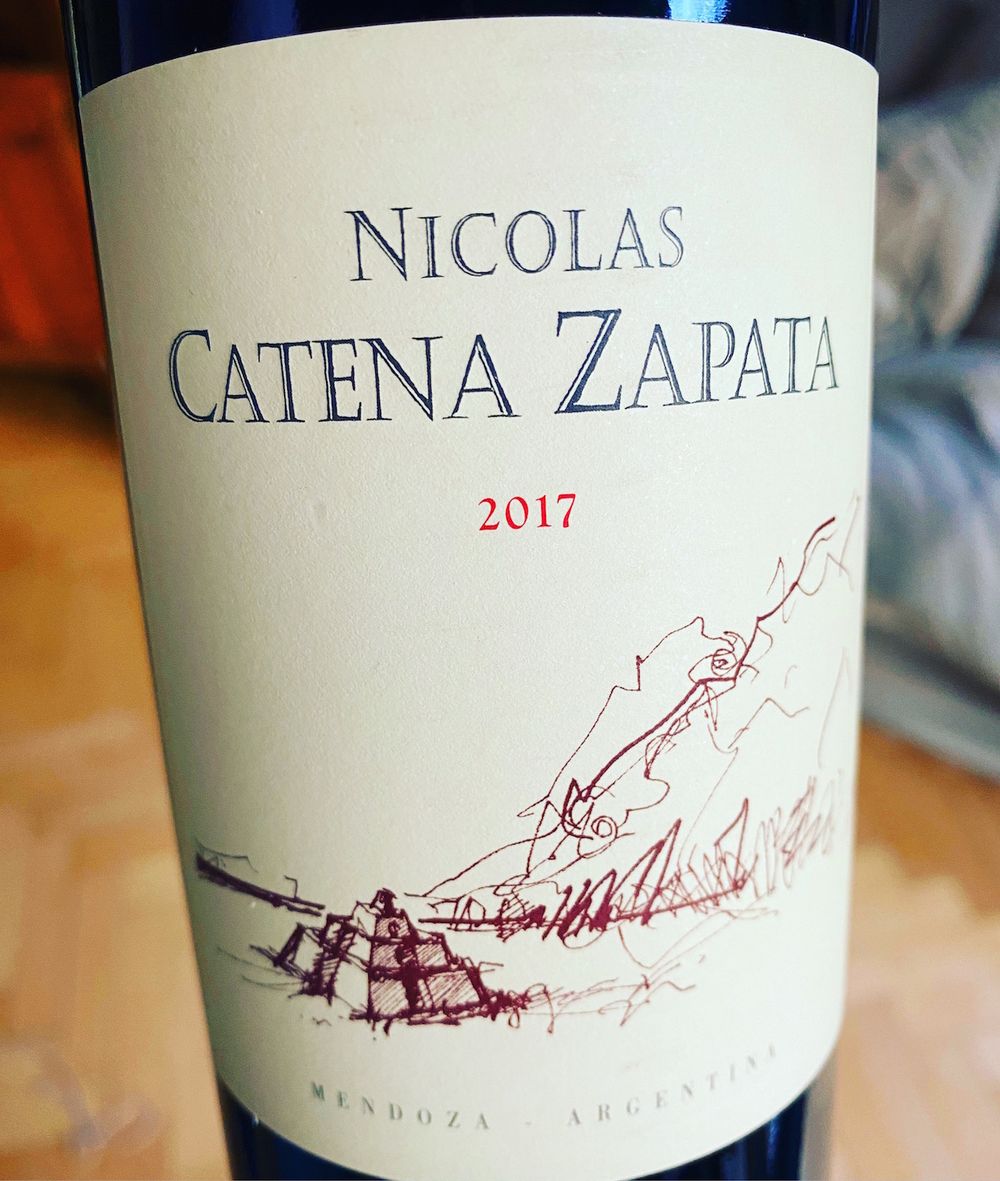For the Nicolás Catena Zapata 2017 Buscema has kept Cabernet Franc in the blend because he feels it is “like the glue integrating Malbec with more challenging Cabernet tannins.”
It takes cojones for a winemaker to ‘mess with’ the blend of his first vintage. Especially when that blend is Nicolás Catena Zapata – Argentina’s first luxury cuvée and a wine that, since the 2015 vintage, has been traded on La Place de Bordeaux, alongside some of the world’s most sought-after and expensive wines. But that is what happened with the 2016 vintage, Fernando Buscema’s first at Catena Zapata, and the coldest and rainiest vintage in Argentina’s history.

Fernando Buscema: “feeling confident, maybe too confident”
Buscema made the wrong call on waiting for a particular plot of Cabernet Sauvignon to ripen over the weekend and got caught out. It was at La Pirámide cru, the estate’s 7 hectare plot of Cabernet Sauvignon which is planted on clay soil at Agrelo, one of seven iconic vineyards Catena Zapata sources fruit from.
“I was feeling confident, maybe too confident,” he says, “maybe my ego got in the middle. The ripeness was not there and we needed to wait.”
So far nothing unusual – he waited – but, this being a Friday, rather than go back the next day and check the ripeness of the grapes, Buscema waited for the whole weekend and returned on the Monday to find the worst. “We had lost the entire parcel and I now had a big problem on my hands, I had made a poor choice, and what you get sometimes is not what you want – it’s what nature gives you.”
The error had an upside, however. What nature had given Buscema turned out to be an amazing stroke of good fortune.
“La Pirámide is the vineyard with the highest quantity of clay of any of our vineyards so I thought ‘what if I have the opposite?’,” Buscema continues. “At Nicosia, for example, we have a vineyard that is on an old riverbed with Cabernet Franc growing on shallow rocky soil – and when you have low temperatures and high rainfall (like we did) grapes grown on shallow soil is much better. So I thought maybe we will get high quality fruit? I went to Nicosia and tasted the grapes and they were just amazing. Cabernet Franc is sometimes overlooked and in 2016 it was the last piece of the puzzle.”
Apart from being one of the most renowned researchers in Argentina, Buscema is also recognised as being an oenologist who has particular skill with blends.
“When you have a jigsaw puzzle you have the right number of pieces but I’m usually given more pieces than I need, but I don’t know what the pieces are that will go into the final blend… nature is not always obvious to us it can be the last piece and take several months to realise.”

Buscema’s Masters from Davis in California, has enabled him to find the best plots for Malbec and Cabernet
Old school claret
Although Catena Zapata has been blending and co-vinifying Malbec with Cabernet Franc since the 1990s, the winery had never done so with one of its iconic wines. Since 2001 when Nicolás Catena Zapata was launched with the legendary 1997 vintage, the wine had only ever been a blend of Cabernet Sauvignon and Malbec (95%/5% in the maiden vintage).
The wine was intended to be a ‘window on the world of old school Claret’, using a blend of grape varieties that used to be the norm in Bordeaux before phyloxerra struck and vignerons replaced Malbec with high-yielding, early-ripening Merlot to quickly make up the yields and avoid two varietals ripening at once. When Italian immigrant Nicola Catena planted his first vineyard in Mendoza in 1902 when he set up the winery, however, the early Atlantic rains that the Bordelais were trying to avoid in the Medoc was not an issue. Malbec grew very well here in Argentina, especially high up and in cooler climes.
Cabernet Franc is also growing well in Argentina and is having a resurgence with winemakers because of its ability to bring freshness and a lighter side to many blends. For Buscema, adding it to Cabernet Sauvignon and Malbec in Nicolás Catena Zapata 2016 was the kind of inspired decision that got him the job in the first place – the 2016 is a mesmerising wine (see notes below), and for 2017 Buscema has kept Cabernet Franc in the blend because he feels it is “like the glue integrating Malbec with more challenging Cabernet tannins.”

Barrels of Cabernet Sauvignon at Catena Zapata
Although the 2016 was Buscema’s first vintage of Nicolás Catena Zapata, he was hardly a rookie winemaker when taken on by wine director of the estate, Alejandro Vigil. Buscema is a man, after all, whose favourite thing to read is ‘Phenolic Composition of Malbec: A Comparative Study of Research-Scale Wines between Argentina and the United States’, a paper he wrote with former UC Davis lecturer and mentor Roger Boulton, and which is considered to be the most exhaustive study of Malbec and which terroir it best thrives in. Argentina is a patchwork of different soils and altitudes and one of Buscema’s key roles, he believes, is matching the right varieties of Malbec in the right locations.
Aside from being the winemaker of Nicolás Catena Zapata, Buscema is also president of Bodegas CARO which is the joint venture between Catena Zapata and Barons de Rothschild, and he is also the executive director of the Catena Institute of Wine, as well as having other gigs at the JA Maza University in Mendoza. Before Catena Zapata and CARO he worked at Lafite in Bordeaux.
“My experience in Bordeaux was amazing – I ended up finding passionate people who know how to read nature, but others who think they are bigger than the site – but if I want to make a really good vintage I have learned to leave my ego outside the tasting room.”

Zoom tasting with Buscema, December 2020
So how are the Nicolás Catena Zapata 2015-7 wines tasting?
Nicolás Catena Zapata 2017
As mentioned, this is only Buscema’s second vintage and a fascinating contrast with the 2016. Although it needs maybe 4-5 more years it is already more open with more heft than 2016 – but with a similar blend of Cabernet Sauvignon 59%, Malbec 33% and 8% Cabernet Franc. Spring frosts brought on by drier and slightly cooler weather resulted in lower yields, an early harvest and a beautiful balance to the wine.
As for the harvest, it is done by hand, and some parcels are fermented as whole bunches to enhance tannic structure and freshness. The fermentation takes place in 500 litre oak barrels, concrete and stainless-steel tanks, at temperatures of 26-28ºC for about 10-15 days. The post-fermentative maceration lasts between 5 and 10 days. The wine carries out its malolactic fermentation and is then aged in French oak barrels for 18 months.
To look at, the wine is deep inky purple, almost opaque. The nose is ripe, more complex at this stage than the 2016, cassis and blackberries to the fore, earthy, with a touch of lifted eucalyptus, and a leafy element. In the mouth it is dense, medium-heavyweight, firm but ripe tannins, which are amazingly well integrated for a wine so young but give a good grip on the long finish. A tad disjointed maybe, and needs more time but it will evolve beautifully – better than the 2016? We’ll have to see, but it will make for a fascinating journey. 13.5% ABV

Nicolás Catena Zapata 2016
The 2016 was Buscema’s first vintage and one where he made the bold decision to include Cabernet Franc into the blend for the first time. It feels more elegant and the fruit sleeker than the ‘15 or ’17 with a notable fresh, fluid quality on the palate. 2016 was the coolest year in the last three decades. Yields were 40 to 50 per cent down throughout the region resulting in extremely concentrated, mineral and age-worthy wines.
The specific proportions of the blend are Cabernet Sauvignon 61% Malbec 31% Cabernet Franc 8%. On the eye the wine is medium purple; there are notes of fresh blackberry, cassis, iodine, red liquorice with a fresh-herbaceous element. Fantastically fresh, elegant, fluid mouth-feel with velvety smooth, fine-grained tannins; the fruit is ripe, but the black fruit is veering more towards the blue plum side of things. The fruit profile is complex, rounded, sleek and feels young on the dry, chalky finish. Quite delicious and an interesting contrast to the 2017. 13.5% ABV
Nicolás Catena Zapata 2015
Many in Mendoza have called 2015 ‘the Bordelais year’ because of the cool summer, early harvest, autumn rains, and generally lower alcohols and high acidities. This was the last vintage before Cabernet Franc was added to the blend, the proportions of which are Cabernet Sauvignon 83% Malbec 17%.
Tasted alongside the 2016 and 2017 this is more ‘settled’, exhibiting some secondary notes, and at the start of its drinking window.
On the eye the wine is deep ruby with lighter edges; there is ripe black fruit with red fruit in the mix both on the nose and on the palate; there is an earthy quality, slightly spicy, mocha, and a wisp of smoke. The palate is medium to full, more textural with fine-grained tannins, black fruit dominates but there is also a macerated strawberry note and a twist of grapefruit citrus in the background. Quite delicious but liking the 2016 and 2017 more. 14% ABV
Nicolás Catena Zapata is stocked in the UK by Bibendum, who is a supplier partner of The Buyer. Learn more about them here.










































